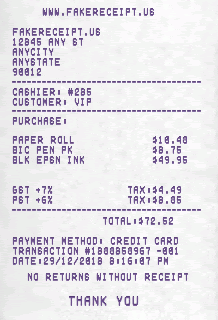A false balance is an abomination to the Lord, but a just weight is his delight. Proverbs 11:1
We are at the end of our discussion of fraudulent disbursements per the Certified Fraud Examiners fraud tree. Please see : http://www.acfe.com/fraud-
If you want to earn CPE credit for reading these articles, please check out the full text at: https://yellowbook.ideamakr.com/
Register Disbursements
Government agencies that transact with the public (licensing departments, toll collection booths, and courts) need cash registers. For instance, the ferry in Seattle is run by King County as of 2011. Plenty of cash changes hands on ferries. An audit in 2011 shows that King County didn’t have systems in place to monitor whether revenue is meeting expectations or if ridership equals dollars collected. In some instances, the cash fares were being stolen.[1]
False Voids
 Anthony Grande, 36, a cashier at the Stop & Shop supermarket was arrested in 2009, accused of skimming more than $102,000 from the cash registers over the prior year. Grande was accused of deleting cash transactions from his register, then pocketing the customers’ money. That would be about $392 per day for a five-day workweek. Cash sales were rung in the cash register, held, and then deleted.[2]
Anthony Grande, 36, a cashier at the Stop & Shop supermarket was arrested in 2009, accused of skimming more than $102,000 from the cash registers over the prior year. Grande was accused of deleting cash transactions from his register, then pocketing the customers’ money. That would be about $392 per day for a five-day workweek. Cash sales were rung in the cash register, held, and then deleted.[2]
The problem most skimmers have with cash registers is the registers’ paper receipts. Traditional skimmers take cash equal to the amount of a sale that they either don’t enter into the register or void after the fact.
Because stealing from the cash register is common in business, owners and managers know to look out for a high number of voids. Skimming without voiding receipts can lead to imbalances on the receipts, which also alerts managers and auditors.
Most registers maintain electronic sales records rather than keeping receipt rolls. Fraudsters use a device called the ‘zapper’ to workaround the electronic sales records. Also known as automated sales suppression devices, zappers are able to change registers’ sales records.
Talal Chahine, who owned a small chain of 12 Lebanese restaurants in Detroit, skimmed over $20 million over four years using a zapper. This allowed him to avoid taxation as well as benefit him personally. Chahine sent a portion of the money he stole from his restaurant La Shish to Hezbollah, an Islamic extremist group.[3]
False Refunds
 Refund fraud is a system that allows individuals and employees to refund merchandise and profit from the returns. Cash is typically used in refund frauds because no paper trail exists.
Refund fraud is a system that allows individuals and employees to refund merchandise and profit from the returns. Cash is typically used in refund frauds because no paper trail exists.
Fraudsters might lift products from a store and then return the stolen products to the same store from which they shoplifted. This works in stores that do not have a policy against returning products without a receipt. When required to give personal information to the store clerk, these fraudsters supply false information.
Another refund fraud involves buying products while they are on sale and then returning them at full price after the sale ends.
Some fraudsters purchase merchandise, use it, and then return it for a refund. For example, an employee might purchase a semi-formal dress, wear it to a party, and then return it to the store for a full refund. Because the product loses quality and value, there’s a risk to the store that it won’t sell. I had a girlfriend in high school that did this! Her favorite target was Neiman Marcus!
In yet another scam, employees might process refunds for items that were not actually returned by customers. Some use legitimate receipts of sales to other customers to refund items on the receipt for cash, or sometimes credit cards. Others may refund items without having a receipt.
In a very creative refund scheme, fraudsters in New Mexico used loadable credit cards at Walgreens. The loadable credit cards don’t have names attached to them, but they do create unique bank accounts. This allowed the fraudsters to file fake income tax returns with the state and request that the tax refund be deposited into these nameless bank accounts. The state obliged and the fraudsters promptly went out and made anonymous purchases using the loadable credit cards. The identities of the frausters were completely anonymous because the fraudsters bought the initial cards with cash at Walgreens.

 Forgery occurs when someone signs another person’s name to a document or alters an original document. I admit to signing my husband’s name on credit card bills at restaurants and stores when he is otherwise engaged. In this case, I am the “maker”; I am the person who forges the document.
Forgery occurs when someone signs another person’s name to a document or alters an original document. I admit to signing my husband’s name on credit card bills at restaurants and stores when he is otherwise engaged. In this case, I am the “maker”; I am the person who forges the document. The biggest drawback to the scheme is that once it is uncovered, the documentation (the endorsement on the check) reveals who committed the fraud.
The biggest drawback to the scheme is that once it is uncovered, the documentation (the endorsement on the check) reveals who committed the fraud. This is when an authorized signer is tricked into signing a check that she really doesn’t see or scrutinize. Imagine a secretary stacking checks for her boss and the boss signing everything in turn without looking at it. It could happen!
This is when an authorized signer is tricked into signing a check that she really doesn’t see or scrutinize. Imagine a secretary stacking checks for her boss and the boss signing everything in turn without looking at it. It could happen! Although this doesn’t relate directly to checks, the authorized maker scheme reminds me of the vulnerability of my bank account from those corporations who are authorized to automatically withdraw funds from my account. My mortgage company and my insurance company always ask me to pay them directly and give them a voided check with all of my account information to set up the withdrawals. They may have all of this information without me sharing it with them intentionally, but I would much rather make the payment myself. I would never want to give a mortgage company this ability – especially given how many times my mortgage has been sold and reassigned over the years. Who are these people, and will they really protect my data?
Although this doesn’t relate directly to checks, the authorized maker scheme reminds me of the vulnerability of my bank account from those corporations who are authorized to automatically withdraw funds from my account. My mortgage company and my insurance company always ask me to pay them directly and give them a voided check with all of my account information to set up the withdrawals. They may have all of this information without me sharing it with them intentionally, but I would much rather make the payment myself. I would never want to give a mortgage company this ability – especially given how many times my mortgage has been sold and reassigned over the years. Who are these people, and will they really protect my data? When I was in college, I worked as an accounts payable clerk at a high tech company for a summer. One of my jobs was to review travel expense reports for compliance with corporate policy.
When I was in college, I worked as an accounts payable clerk at a high tech company for a summer. One of my jobs was to review travel expense reports for compliance with corporate policy.
 Yes, another Medicaid story! The plethora of Medicaid stories shouldn’t be too surprising since over 20% of our federal budget is spent on Medicaid.[4]
Yes, another Medicaid story! The plethora of Medicaid stories shouldn’t be too surprising since over 20% of our federal budget is spent on Medicaid.[4] Have you seen the website that lets you create fake receipts? Just Google ‘fake receipts,’ and Google lists pages and pages of sites. One of the sites is generic, but for a small fee you can upgrade to get better logos for well-known companies. Here is an image of what you can create using one of these sites:
Have you seen the website that lets you create fake receipts? Just Google ‘fake receipts,’ and Google lists pages and pages of sites. One of the sites is generic, but for a small fee you can upgrade to get better logos for well-known companies. Here is an image of what you can create using one of these sites: Looks pretty good, doesn’t it?
Looks pretty good, doesn’t it? Yellowbook-CPE.com is registered with the National Association of State Boards of Accountancy (NASBA) as a sponsor of continuing professional education on the National Registry of CPE Sponsors. State boards of accountancy have final authority on the acceptance of individual courses for CPE credit. Complaints regarding registered sponsors may be submitted to the National Registry of CPE Sponsors through its website:
Yellowbook-CPE.com is registered with the National Association of State Boards of Accountancy (NASBA) as a sponsor of continuing professional education on the National Registry of CPE Sponsors. State boards of accountancy have final authority on the acceptance of individual courses for CPE credit. Complaints regarding registered sponsors may be submitted to the National Registry of CPE Sponsors through its website: